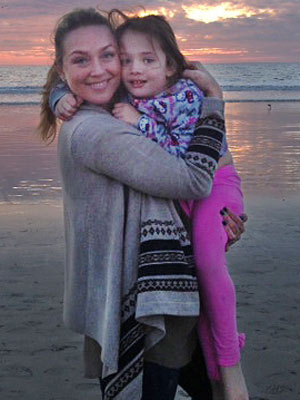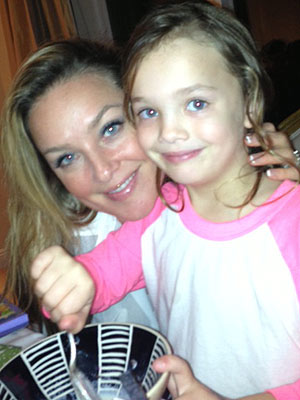
Beautiful sunset – Courtesy Elisabeth Röhm
Elisabeth Röhm, best known for her roles as Serena on Law & Order and Kate on Angel, has been blogging for PEOPLE.com for two years now.
The actress, 39, currently stars as Taylor on The Client List, while her film In the Dark re-airs on Lifetime throughout January.
Her book, Object of My Conception: A Journey to Motherhood Through IVF, will be released by Da Capo in April.
She can be found on Facebook, Google + and @ElisabethRohm.
In her latest blog, Röhm — mom to 4½-year-old Easton August with fiancé Ron Anthony — opens up about the loss of her Aunt Lolly and how recent events have her considering how much Easton actually understands.
No one likes to cry in front of people. I’m sure most of us can say we don’t like to cry at all. We certainly don’t like to cry in front of our kids or emote feelings that are overwhelming to us. But what happens when we are sad, tired, temporarily defeated, grieving or just plain exhausted by life? What happens when we are human and not the demi-God our children think we are? What do we do with our tragic flaws?
How do we handle our feelings in front of our kids? Those precious, innocent kids that simply don’t get the scope of whatever it is we’re experiencing or feeling? They simply don’t get it. Or do they?
Isn’t it our job to protect them from the harsh realities of the world, our world and yes, soon-to-be their world? Are we supposed to hide in a closet, a bathroom or our bedrooms and let it all out in private? Are we supposed to bottle our cries and our stresses until we wave the school bus good-bye, or we drive away from their academic establishments after morning drop-off?
Is that right and fair to us moms who are just trying to get by, all the while juggling the various things that make us those invincible superstars that get to be called Mom, Mommy, Mama? Isn’t it beneficial for them to understand the complexity of us mommies and the complexities of life?
I’ve never been closeted or one for locking the bathroom to privately exhale, shed a few tears or simply decompress before I lose it. I’m very open and actually really enjoy sharing and perhaps over-sharing. Why hide in the closet trying to stifle our sobs over love, money, career or the fact that our hormones have gotten the best of us and sometimes get in the way of our ordinary sanity?
We should communicate with our loved ones. But our children; our children, who are a part of our bodies and souls and feel every emotion, experience and reaction that course through us even before we’ve uttered a word, yelp or deep sigh of frustration?
Not to mention the bigger burdens of loss, death, the news that so often deals with death and dying or grief. What if we lose a loved one? How do we explain the tears that can come brimming over our lashes and down our face without our permission?
Even if we’d like to be the happiest, go luckiest, best, most responsible stable mothers, sometimes things get too hard, tiring, staggering and quite simply sad on a given day — making it near impossible to be the supermom we see ourselves as.
Sometimes life does get the best of us, doesn’t it?
We experience our life as it unfolds before us and sometimes we notice that the image of ourselves as a “perfect parent” is just not matching up. That can make us feel very vulnerable as parents who are supposed to shoulder it all with an endless waterfall of smiles and unconditional strength.
I know, oh how I know! What did Jack Lemmon say? “It’s show-time!” For parents, it’s “show-time” all the time, right?
No matter if we are burned out, stressed out or tapped out, our children look to us for unwavering calming love, security and safety and most of all joy. So what do we do when we feel like we are coming apart at the seams like a poorly-crafted stuffed animal, with all that cotton ball stuffing poking out in the most unflattering of ways?
Is it really the most responsible choice to hide out where little prying, wide eyes can’t see their parents losing their — you know what — @##^*%^&*%^-cookies?
Having lost my mother three years ago, I tried so very hard to keep my deepest grief private, but as our kids get older it’s a little harder to hide those truthful emotions. They are so sensitive and curious.
As they grow we wonder what parts we should share, what’s beneficial and helpful in growing them up into mature, wise beings who understand that feelings are not scary and challenging experiences are a part of life — you can’t avoid them even if you want to.
And also, this is a BIG one: that dying is a part of living. It is natural and painful and transformative.
Saturday afternoon, late in the day, as I was cleaning out Easton’s closet to add to that ever-evolving hand-me-down bag of kid stuff for a girlfriend, the telephone rang with tragic news. My beloved Aunt Laurie, who I’ve referred to many times in my blog as “Lolly,” had shockingly passed away from a sudden and unexpected heart attack. Too young to die, like my mother was.
The news hit me like a freight train and I fell to the ground flooded by my pools of tears.
Easton was so confused and concerned. Since she is almost 5, I tried to explain to her what happened. At first I thought she was getting it. Then I realized that she really wasn’t getting it. After 10 minutes of crying and hugging her tight on the kitchen floor whilst I tried very carefully and thoughtfully to explain where “Lolly” had gone and why I was so upset, I realized it was better left unsaid.
I pulled myself together, self-conscious of my parenting, and stuffed my feelings in the back pocket of my jeans so as not to worry her any further.
It reminded me of my mother all over again, and how I tried to shield Easton from my loss. The experience was just too complicated for a little person — or so it has seemed. And really, why make Easton endure along with me what would mostly be an onslaught of confusing emotions from her mother? Better to deal with it on my own in the closet, right?
As the days have gone by, I’ve kept my tears saved up for those moments that she’s not around, just like I did when Mom passed away. I’ve waited until I’m in the shower, the car or she’s gone to sleep to break into a million pieces of angels wings that flutter into the heavens where my beloved mother and aunt are now.
I hope I’m being a conscientious parent — or am I?
As I left for the airport Tuesday to go to my Aunt Lolly’s funeral, my daughter still seemed confused by my leaving and the idea of death, as I tried once more to explain where Mommy was going for several days. She just looked at me with shiny blue eyes, blinking with the innocence of kind-of-sort-of getting it but not.
I guess that confirmation again made me feel clear that it’s been better for Easton that I keep my grown-up feelings to myself.
This scenario of late begs the question of talking and sharing with our children about other heavy subjects like arguments, breakups, divorce, moving, money issues, news, loss, fear and all other forms of pain in our big adult lives, doesn’t it?
Several weeks ago, there was some quarreling going on between Ron and me. It became a discussion as to if we should try to explain the bickering to Easton or if it was better to assume that she wouldn’t grasp all the details anyway and to protect her altogether.
On one hand, you could say that children do get it all and are highly sensitive — even to the tense and hushed discussions that you try to keep private — and that in order for them to feel safe, the parents should include the child in what they are witness to.
On the other hand, when we asked Easton in loving and nurturing tones if she had any questions or was worried at all by what Mommy and Daddy were talking about, she simply said, “No.”
We pressed and said, “Because we’ll always explain everything to you and always tell you the truth. You sure you don’t have any questions or concerns?” “Nope,” she said, assuredly and clearly, and then she was off to a game of hide and seek with her Aunt Olivia.
Where do you stand on all of this, ladies? Where do you draw the line? Do you cry, fight, share grief and stress, watch the news, talk openly and show your emotions without question or regret in front of your wee-ones?
Let’s discuss any ah-ha moments where you realized you needed to share more or less, realized you were sheltering or over-exposing your children to life’s tragedies and cruelties.
I always love the conversations that we share, the debates, the memories of our lives and those poignant learned lessons!!
Looking forward to another year of blogging with you and wishing a blessed and abundant New Year for you and your families.

With my girl – Courtesy Elisabeth Röhm
Until next time…
– Elisabeth Röhm
More from Elisabeth’s PEOPLE.com blog series:















